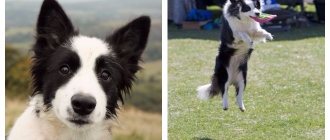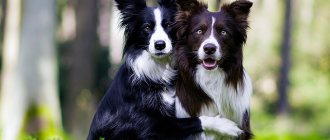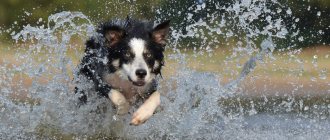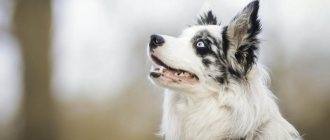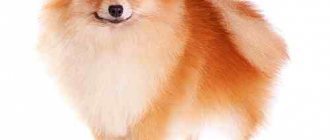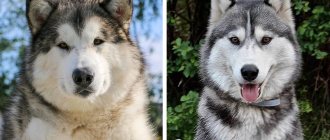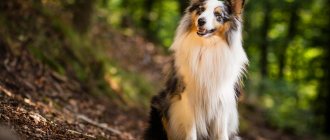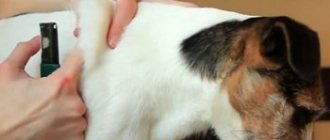| Origin: | Great Britain |
| Usage: | herding dog |
| Color: | black and white, red, sable, etc. |
| Dimensions: | height 47-53 cm, weight 15-22 kg |
| Lifespan: | 14-16 years old |
The border collie is a rather rare breed of herding dog in Russia. This is an amazing animal that has an almost human mind and the ability to feel the mood of its owner. The article provides basic information about the breed - external features, nuances of character, maintenance and upbringing.
Breed standard
The Border Collie standard describes the dog as graceful, harmonious, but at the same time strong and athletic. Animals with an excessively rough build or too shaggy coat are not welcome.
The document shows the optimal sizes of a border collie:
- the ideal height of a border collie for males is 53 cm, for females – a few cm less (47-52 cm);
- The weight of the animal is proportional to its height. Usually it ranges from 15-22 kg.
The animal's movements are free and graceful. When running, the dog raises its paws minimally - it seems as if it is sneaking at great speed. Representatives of the breed are excellent jumpers - they easily overcome obstacles that are several times higher than their own height.
| Official description of the breed (FCI standard No. 297): | |
| Become | Breed characteristics |
| Head | Wide, proportional to the body. The distance from the stop to the occipital protuberance is equal to the distance from the stop to the tip of the nose. The stop is clearly visible. |
| Muzzle | Medium length, wedge-shaped. |
| Nose | The nostrils are wide. The lobe is black; in animals of blue color it is gray. If the Border Collie dog has a liver or chocolate color, then brown pigmentation is allowed. |
| Jaws | Powerful, set in a scissor bite. |
| Eyes | Almond-shaped, widely set. The color of the iris is brown. The merle Border Collie may have a blue tint. The look is attentive, thoughtful, calm. This feature is reflected in any photograph. |
| Ears | Medium, rather dense, standing or semi-hanging. They are located at a considerable distance from each other. |
| Neck | Long, athletic, graceful. Smoothly expands as it approaches the body. |
| Torso | Stretched format - length greater than height. The chest is powerful, the muscles on the back are well developed. |
| Tail | It is medium in size, covered with thick fur, reminiscent of a fox. In a relaxed state it is lowered down; when working, the animal lifts it up, but never throws it over its back. |
| Limbs | Arranged in parallel. The paws are rounded, compact, the toes are tucked, the claws are small and very strong. |
Representatives of the breed have a dense coat with a thick undercoat that protects against temperature changes. Thanks to it, the animal can work in almost any weather conditions. The breed is divided into 2 varieties:
- smooth-haired;
- long-haired
Animals of the latter species have a mane, “pants” and a tassel on the tail. The fur on the head, ears, and paws is short and straight. Any non-compliance with the standard is considered a deficiency. Its severity is considered in accordance with the degree of impact on the health and performance of the animal.
What a border collie looks like, according to the standard, can be seen in the photograph.
History of the Border Collie Breed
Where, when and how exactly the first border collies (or dogs very similar to them) appeared is not known for certain. It is generally accepted that this breed of herding dog was bred to help farmers who lived somewhere on the border of Scotland and Britain - hence “border”: this word is translated from English as “border”. But the etymology of the second part of the breed name is more interesting. In the Scottish dialect, the word “coal” means “coal” - so what does a dog have to do with it, it seems? The fact is that the Scots from ancient times preferred a special breed of sheep with a coal-black muzzle and affectionately called them “collies.” Then the name passed on to the dogs who herded these same sheep.
There was a special demand for short shepherd dogs, since such fast beaters easily gathered the herd into a heap and drove it in the right direction, while dodging the blows of the hooves. Border collies began their “career” by herding sheep: and then they began to herd cattle and even poultry.
Old Hemp is considered the progenitor of the Border Collie, was distinguished by unique working qualities and left numerous offspring
The beginning of systematic work on the formation of a breed type dates back to 1873, when several dozen rather different types of dogs were collected in Wales for practicing herding tests. Since then, enthusiasts have painstakingly “sculpted from what was” the image of the breed. Only in 1894 was a puppy born, who received the name Old Hemp and literally became the father of the Borders - the pedigrees of most breed lines go back to this wonderful dog.
Border Collie loves space and freedom
But it took almost another hundred years until the Border Collie breed finally received its first well-deserved recognition: in 1976, Border Collies were officially recognized by the English Kennel Club, in 1987 the breed standard was approved by the FCI, and in 1995 the American Kennel Club completed the marathon internationally recognized border collie.
Border collies enthusiastically do their favorite job - herding livestock and birds.
In their historical homeland, as in some other European countries, borderers continue to do what they love - they herd cattle. Meanwhile, the popularity of this interesting breed is growing all over the world, which is often perceived as purely for show or even decorative. And this is where the big mistake lies.
The Border Collie is considered the smartest breed in existence.
Breed types and varieties
Due to the fact that the breed was formed in different environmental conditions and with different working tasks, historically there were four types of border collies, which then had to be “adjusted” to a single standard:
- Northumbrians are squat, strong dogs of medium size, with rather long and rough hair, predominantly black and white with a dominant black color;
- Wiston Cap is a lightweight type of build, the color is also black and white, but there is more white than in the first version;
- Nap - these border dogs were initially distinguished by their compact format, smooth short coat with a thick undercoat and excellent working qualities;
- Herdman's Tommy is the youngest Northumbrian-derived breed, characterized by heavier bone and black and tan coloring.
At first glance, these are very different dogs, but they are all border collies
These breed types gave rise to the great external diversity of modern border collies. Now the standard distinguishes only two varieties of this breed: smooth-haired and long-haired.
Colors
The FCI breed standard allows for a variety of border collie colors, since the selection process focused on the working qualities of the animals, and not on their appearance. However, in none of the options is white the main color. The classic color is black and white. The light shade predominates on the face, chest, belly, limbs, and tail. The dog may be spotted: there are small specks on the white areas, which appear a few days after birth. The following colors are also common:
- red (chocolate, brown, liver);
- tan (shades from pale beige to dark red);
- gray (smoky);
- sable;
- ginger.
There is a tricolor color - combination:
- white;
- any other color (black, blue, brown, etc.);
- tan (shade from light beige to deep red) under the eyes, on the cheekbones and limbs.
Solid black color is not typical for the breed.
The marbled border collie looks beautiful and original: photos of these animals immediately catch your eye. Such pets often have heterochromia, which gives them even more charm. However, it is undesirable to cross two merle-colored dogs - the puppies are usually born dead, and if they survive, they have many congenital pathologies.
Merle Border Collies come in a variety of shades. The dog can be red, blue, red, sable, etc. The body of the animal is covered with richly pigmented or pale spots of varying sizes.
Also, all of these types may contain tan. Then the color will be correctly called, for example, marbled sable and tan. Puppies obtained from chocolate and blue individuals are lilac colored, a very rare color that is a mixture of brown and blue. Sometimes this color is called Isabella.
Character
Representatives of the breed have a friendly character. Animals are active, attentive and responsible. They are not characterized by malice or cowardice. Pets are distrustful of strangers, but do not show obvious aggression.
This is a dog of more than one owner - it loves all family members equally. The pet loves to accompany the owner everywhere, but does not impose himself. Animals make contact only when people need their attention.
All types of collies (Blue Lacy, Aussie, Sheltie, Shorthaired Collie, etc.) are highly trainable. However, according to British scientists, it is the border collie that is the smartest dog. Owners teach their pets incredible tricks. For example, walking on your front paws.
However, learning should be interesting. If the dog gets bored, he will pretend to be stupid, sick, or suddenly go deaf. This behavior must be stopped, otherwise it will develop into a bad habit.
The high intelligence of animals also gives rise to disadvantages of the breed. These dogs are cunning: they try to manipulate the owner, forcing him to do what is convenient for them. You should not react to such provocations. When the pet realizes that the trick was unsuccessful, it will become obedient again.
If it is difficult to train an animal on your own, you should use the services of a dog handler who knows the characteristics of this breed well.
The dog should not be left idle. If the owner does not use it for its intended purpose, then another job is found for the pet. For example, they do agility or Frisbee.
Socialization
Socialization of the puppy begins immediately after it arrives in the house. He is introduced to the outside world, other animals and people, and is taught not to be afraid of the noise of the big city. To prevent the baby from being mischievous, he is provided with a variety of toys. The more there are, the better. Hyperactive puppies require strict discipline.
The dog needs to satisfy not only the need for movement, but also to develop intellectually.
Character formation is completed at approximately six months. Until this time, it is still possible to correct some temperamental deficiencies. Retraining an adult animal will be much more difficult. If your pet does something wrong, just change your intonation to strict - he will quickly understand the mistake. You cannot use physical force - representatives of the breed are very vulnerable and sensitive to violence. Border Collies and children get along great. The pet especially likes to spend time with teenagers - after all, you can run with them and do active entertainment. A properly socialized dog gets along with other pets and does not conflict with its relatives.
How to choose a puppy
Before buying a puppy, it is advisable to visit exhibitions and chat with other owners to learn everything about the breed. Then you should choose a nursery by studying reviews on the Internet. It is recommended to purchase pets from organizations registered with the RKF and having a good reputation.
A responsible breeder will be happy to answer your questions, tell you everything about keeping and feeding the puppies, and also point out the pros and cons of the border collie.
This active pet is not suitable for every person - homebodies should take a closer look at another breed.
It is also necessary to get to know the animal's parents. Good heredity guarantees the physical and mental health of Border Collie puppies.
Pros and cons of the border collie
Like any breed, these dogs have their positive and negative sides. Before getting a border collie, you need to familiarize yourself with the comparative table of pros and cons.
| Positive traits | Negative traits |
| Smart, obedient, independent | Can manipulate the owner or household members |
| They are excellent to train, even a beginner can cope with their upbringing. | Find it difficult to bear loneliness |
| Non-aggressive, friendly | Prone to escape (easily overcome high fences, dig tunnels) |
| Have good health and live long | If not handled correctly, they become very timid or aggressive |
| They get along with children, love them, and are not jealous | Need movement and mental exercise |
| Suitable for active activities, share a treadmill, bike ride with the owner, love to swim | They do not protect territories and things |
| Used as search and rescue dogs | In such individuals the shepherd instinct sometimes awakens |
If you need a vigilant guard, you should look for him among other breeds.
Older people who like to sit on the couch should not get a Border Collie dog.
Features of maintenance and care
This breed is best owned by owners of private houses. But with long-term walking, pets successfully live in an apartment. The animal cannot be chained or locked in an enclosure - this is not a guard dog. For full development, he needs regular physical and intellectual exercise. Keeping and caring for a pet does not have any specific features. The only caveat is excessive activity. You need to walk your dog a lot, otherwise it will develop bad habits.
Grooming
The long-haired collie is more difficult to care for - it needs to be brushed daily, otherwise the fur will become matted and lose its shine. Some owners trim the fur on their paws to prevent dirt from accumulating on it. A smooth-haired dog requires less attention - it is enough to tidy up its coat a couple of times a week. But during seasonal molting you will have to do this every day. Pets' eyes and ears are also cleaned regularly. If a dog walks on soft ground, its nails must be trimmed. Animals are bathed as they become dirty, but not more than once a month.
Walk
The Border Collie needs to move a lot, play, and communicate with its owner. Pets are walked 2 times a day for at least 1 hour.
With a lack of movement, the dog begins to play pranks and destroy everything in the apartment.
Feeding
The Border Collie breed is undemanding in food, however, due to its high mobility, the dog requires high-calorie and properly balanced food. The animal’s diet can consist of natural food or industrial feed of premium and super-premium classes. It is not recommended to mix both menus. You should not overfeed the animal - the large size of an adult dog and excess weight in combination with physical activity lead to the development of joint diseases.
Characteristics and standards
Border and collie are medium breeds; the size of an adult dog does not exceed 55 cm at the withers and weighs 15-20 kg. There are two officially recognized varieties: short-haired and long-haired. These are lively, intelligent, loyal dogs with excellent working qualities and the ability to train.
The FCI standard ranks the Border Collie breed in the second section (shepherd dogs) of group 1 (cattle and herding dogs) and records the following characteristics:
- The head is proportional, with a clear transition from the lobe to the forehead, short, wide, narrowed towards the nose.
- The eyes are oval shaped and small in size. The iris is brown, but in representatives of the merle color it is light. Heterochromia is allowed (one blue, one dark, or several colors on the iris).
- The ears are semi- or erect, mobile with widely spaced cartilages.
- Scissor bite, overbites and underbites are a defect.
- The neck is developed, muscular, flexible, widened towards the scapular area.
- The body is slightly stretched, exceeding the height at the withers with a developed sacral region. The chest is wide.
- The forelimbs are parallel, the shoulder blades are shifted towards the croup, the wrists, when viewed from the side, are slightly sloping.
- Hind legs with well-developed muscles, long, deep hips, pronounced hocks and bone structure.
- The paws have an oval shape, short, strong claws, and fleshy pads.
- The tail is hooked, with a curl at the end, set low, reaching the hocks, and fluffy. When excited, it can rise, but not above the line of the back.
- The coat is thick, with a dense, soft undercoat. Long-haired Border Collies have feathering on their paws, a mane, and a bushy tuft at the end of their tail. The body and muzzle are covered with short, straight hair.
- Colors can be varied: black and white, brown, red, chocolate, blue, marbled. White plays a secondary role in any of them. There are tricolors.
- The breed's character is balanced, friendly, without signs of cowardice or aggression towards people and animals.
- Movements are smooth, energetic, graceful. The general impression is that the collie can move quickly and silently. When walking, the paws leave the ground minimally.
- Life expectancy is often 15-17 years.
Any deviation from the accepted standard is considered a defect that interferes with breeding and exhibition careers.
In collie males, one of the disadvantages is cryptorchidism (descent of one testicle into the scrotum).
Health
Representatives of the breed are strong and hardy dogs. How long a border collie lives depends on heredity and living conditions. With proper care, the life expectancy of animals is 15 years.
Diseases
In rare cases, dogs of this breed suffer from the following diseases:
- congenital deafness;
- epilepsy;
- malignant hyperthermia;
- retinal atrophy;
- osteochondrosis;
- hip dysplasia.
For preventive purposes, you should visit the veterinarian twice a year. A specialist will be able to identify the disease at a very early stage and take appropriate measures.
Vaccinations
Concern for the primary vaccination of puppies falls on the shoulders of the breeder. At approximately 2 months of age, dogs are vaccinated against the most common diseases:
- carnivore plague;
- infectious hepatitis;
- parvovirus enteritis;
- coronavirus;
- parainfluenza;
- leptospirosis;
- trichophytosis.
After 2-3 weeks, the vaccine is reintroduced. At 6 months they give a rabies injection. Adult border collies are revaccinated annually and treated for parasites every 3 months.
Genetic diseases of border collies
Border collies still remain one of the healthiest dog breeds. They are not wildly popular, so most matings occur in professional nurseries, and not for fun. Moreover, selection is still made not so much by appearance, but by working qualities.
However, some genetic diseases do circulate in the breed. For some of them, a dog can be checked using genetic tests.
Eye diseases
Border collies may have a variety of retinal pathologies, which eventually lead to blindness:
- collie eye abnormality
- progressive retinal atrophy
- retinal dysplasia
They also have cataracts (clouding of the lens), lens luxation, and glaucoma (increased intraocular pressure).
Joint diseases
Border collies being bred must be tested for hip dysplasia (x-rays under general anesthesia). Unfortunately, this disease is circulating throughout the breed. There are also developmental disorders of the elbow joints. The first sign of such problems is lameness in a young dog.
An older Jack Russell and a young shorthaired border collie. Photo courtesy of @._bordermaus_bonny._
Cyclic neutropenia
This is a blood disease in which the number of neutrophils periodically sharply decreases. Dogs with cyclic neutropenia usually do not survive past 2 years of age due to their susceptibility to infection and bleeding. Sick puppies are easy to recognize - they are smaller than their littermates, and the first signs of illness appear as early as 2-3 months.
The problem is that the disease is transmitted in a recessive manner. A dog may not be sick, but be a carrier of a defective gene. If you breed two carriers, the disease will appear in 25% of puppies. Therefore, it makes sense to conduct genetic testing of breeding dogs.
Another name for the disease is gray collie syndrome, as it is accompanied by lightening of the color.
The blue merle color has nothing to do with gray collie syndrome
Epilepsy
Idiopathic (hereditary) epilepsy occurs in Border Collies. This is a rare disease, but the problem is that breeders often keep silent about the appearance of epileptics in the breeding line. Symptoms of the disease (fits with convulsions) first appear between the ages of 2 and 5 years.
Mating
Allowed for mating:
- males over two years old;
- bitches after the start of the third heat.
Border collie dogs that are too young will not be able to bear full-fledged offspring.
Mating is carried out in the morning on an empty stomach. The “partners” are first introduced, otherwise the bitch will not let the male in.
Border Collies are free-bred, but young animals are better bred by hand. It is advisable to invite an experienced breeder who will supervise the process. The next day, re-pairing is scheduled to increase the likelihood of conception.
Bitches most often whelp on day 63, but the duration of pregnancy ranges from 56 to 72 days.
If a dog cannot give birth for a long time, you need to contact a specialist. a delay indicates the presence of pathologies. healthy animals produce 6-8 puppies in one litter.
How much do border collie puppies cost?
The cost of puppies is determined by:
- title of parents;
- litter size;
- compliance of the animal with the accepted standard;
- purchasing power of people in a particular region.
How much does a border collie puppy cost:
- the cost of a pet class pet is 30-40 thousand rubles;
- price of a breed-class puppy – from 50 thousand rubles;
- for a show-class animal you will have to pay from 70 thousand rubles.
Private individuals sell puppies much cheaper - for 12-20 thousand rubles. However, an undocumented pet may have hereditary diseases or be a mixed breed.
Puppy cost
The price of a puppy depends on its origin.
- You can buy a baby from your own hands, the seller will claim that the litter is the result of an unscheduled mating, so there are no documents, offer to see mom and dad live or from a photo and ask for about 1,000 to 5,000 rubles. It is unknown who will grow out of the toddler in the future. Such a dog is prohibited from entering exhibitions, it is not subject to breeding, and after a while it may develop various diseases.
- For a puppy of titled parents who participated in exhibitions, with a full set of documents, you will have to pay 10-25 thousand rubles. A less distinguished, promising baby with a metric mark and a rare color will cost the same.
- Over 20 thousand rubles. The kids are show class. They even look different. It is advisable to buy such a dog if you plan to attend exhibitions, engage in breeding, or start a kennel.
Sales advertisements can also be found on free service websites. But in them, would-be breeders often try to pass off mestizos as purebred puppies, citing the lack of documents as the reason that they didn’t want the paperwork.
